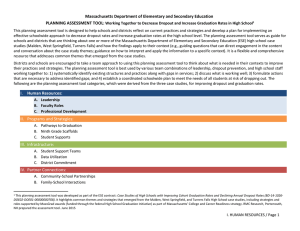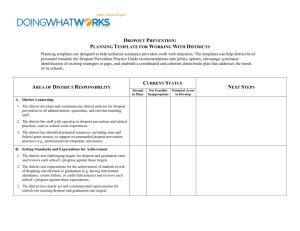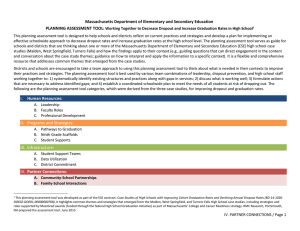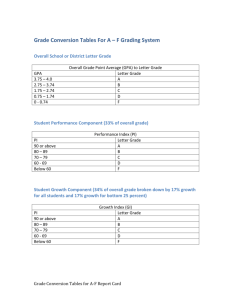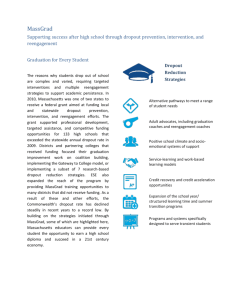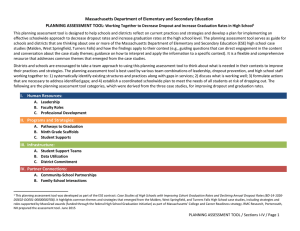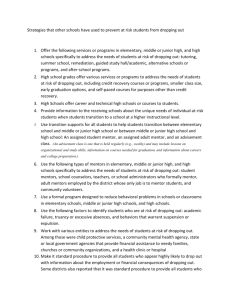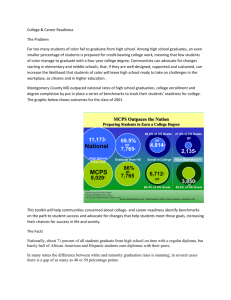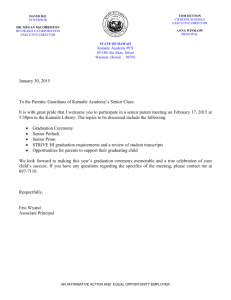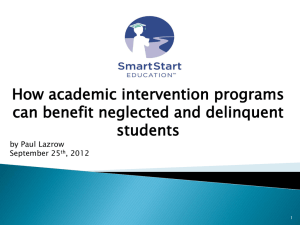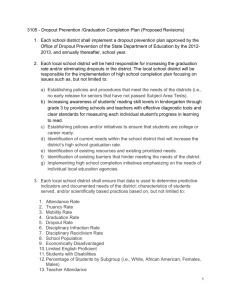MA High School Case Study Tool Section III
advertisement
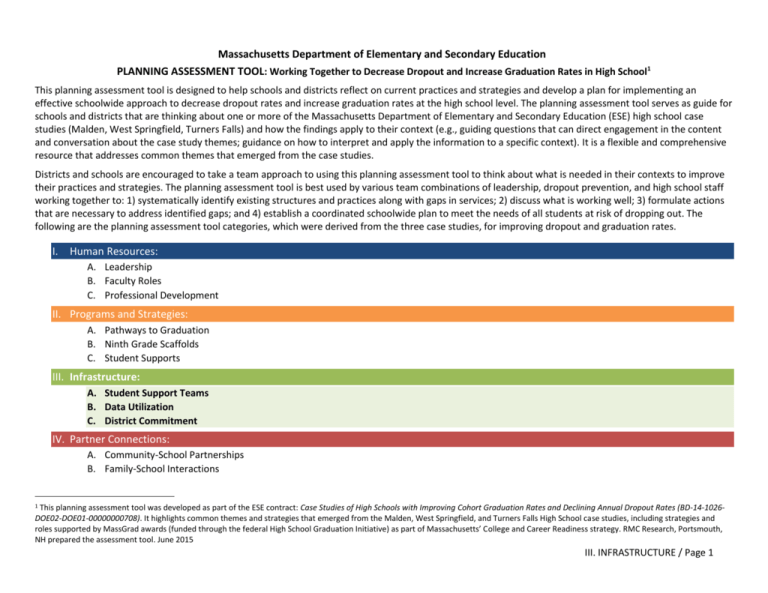
Massachusetts Department of Elementary and Secondary Education PLANNING ASSESSMENT TOOL: Working Together to Decrease Dropout and Increase Graduation Rates in High School1 This planning assessment tool is designed to help schools and districts reflect on current practices and strategies and develop a plan for implementing an effective schoolwide approach to decrease dropout rates and increase graduation rates at the high school level. The planning assessment tool serves as guide for schools and districts that are thinking about one or more of the Massachusetts Department of Elementary and Secondary Education (ESE) high school case studies (Malden, West Springfield, Turners Falls) and how the findings apply to their context (e.g., guiding questions that can direct engagement in the content and conversation about the case study themes; guidance on how to interpret and apply the information to a specific context). It is a flexible and comprehensive resource that addresses common themes that emerged from the case studies. Districts and schools are encouraged to take a team approach to using this planning assessment tool to think about what is needed in their contexts to improve their practices and strategies. The planning assessment tool is best used by various team combinations of leadership, dropout prevention, and high school staff working together to: 1) systematically identify existing structures and practices along with gaps in services; 2) discuss what is working well; 3) formulate actions that are necessary to address identified gaps; and 4) establish a coordinated schoolwide plan to meet the needs of all students at risk of dropping out. The following are the planning assessment tool categories, which were derived from the three case studies, for improving dropout and graduation rates. I. Human Resources: A. Leadership B. Faculty Roles C. Professional Development II. Programs and Strategies: A. Pathways to Graduation B. Ninth Grade Scaffolds C. Student Supports III. Infrastructure: A. Student Support Teams B. Data Utilization C. District Commitment IV. Partner Connections: A. Community-School Partnerships B. Family-School Interactions 1 This planning assessment tool was developed as part of the ESE contract: Case Studies of High Schools with Improving Cohort Graduation Rates and Declining Annual Dropout Rates (BD-14-1026DOE02-DOE01-00000000708). It highlights common themes and strategies that emerged from the Malden, West Springfield, and Turners Falls High School case studies, including strategies and roles supported by MassGrad awards (funded through the federal High School Graduation Initiative) as part of Massachusetts’ College and Career Readiness strategy. RMC Research, Portsmouth, NH prepared the assessment tool. June 2015 III. INFRASTRUCTURE / Page 1 RATE CURRENT STATUS SCHOOL STRUCTURES, PRACTICES, STRATEGIES Fully in Place Partially in Place Not Yet in Place DISCUSSION NOTES (WHAT’S IN PLACE?) III. INFRASTRUCTURE A. STUDENT SUPPORT TEAMS 1. A student support team type structure is in place for the school’s adults to communicate frequently and regularly about their reasoning and decisions regarding individual students, and to make sure they are doing what is best for each student. 2. The student support team makes decisions about planning interventions and securing additional services for individual students. 3. The school’s student support team is empowered to apply academic interventions in a flexible manner (e.g., double doses of academic courses, credit recovery). 4. The student support team has flexibility that allows them to address individual student crises immediately. 5. Counselors are an integral part of academic and support teams working with students at risk for dropping out of school and provide intense individualized services to support students and families. 6. A process for recording and tracking academic and counseling services provided to at-risk student has been established to coordinate the timely delivery of supports and avoid overlap and duplication. 7. The student support team meets as a group with a student or family to send a unified message. III. INFRASTRUCTURE / A. Student Support Teams / Page 2 PLANS FOR NEXT STEPS III. INFRASTRUCTURE / A. STUDENT SUPPORT TEAMS 1. Review the discussion notes and identify common themes – Are there underlying needs (e.g., additional guidance staff) or common desired strategies (e.g., professional development in working with struggling students)? 2. Note the themes below and discuss priorities – Which approaches can be accomplished without additional resources and which require a longer-term strategy of reallocating resources? 3. Use that information to determine next steps – Consider a multi-prong strategy that will bring about some “quick wins” while you are working toward longer-term changes. III. INFRASTRUCTURE / A. Student Support Teams / Page 3 RATE CURRENT STATUS SCHOOL STRUCTURES, PRACTICES, STRATEGIES Fully in Place Partially in Place Not Yet in Place DISCUSSION NOTES (What’s in Place?) III. INFRASTRUCTURE B. DATA UTILIZATION 1. The school has a designated data team (or other group) that examines multiple data sources on a routine basis (e.g., tracking early warning and attendance data, reviewing grades and discipline data, and reviewing experiences of students and recent graduates through the state data system) to stimulate discussions about the scope and nature of dropout patterns at the school (e.g., credit attainment, obstacles to graduation) and generate program improvements to support student graduation success. 2. Data tools (e.g., Early Warning Indicator System) are used to identify and monitor progress of at-risk ninth graders. 3. The high school has a designated data team (or other group) to monitor and review early warning indicators, maintain a watch-list of at-risk students, and inform other teams and staff. 4. The data team (or other designated group) recommends or establishes appropriate interventions for students at key transitions (e.g., students moving from one grade to the next, nearing graduation). III. INFRASTRUCTURE / B. Data Utilization / Page 4 RATE CURRENT STATUS SCHOOL STRUCTURES, PRACTICES, STRATEGIES Fully in Place Partially in Place Not Yet in Place DISCUSSION NOTES (What’s in Place?) III. INFRASTRUCTURE B. DATA UTILIZATION 5. Data team staff meet with teachers and counselors working with students at risk of dropping out to review, analyze, and use data to plan and coordinate instruction and behavioral or other support strategies for students. III. INFRASTRUCTURE / B. Data Utilization / Page 5 PLANS FOR NEXT STEPS III. INFRASTRUCTURE / B. DATA UTILIZATION 1. Review the discussion notes and identify common themes – Are there underlying needs (e.g., additional guidance staff) or common desired strategies (e.g., professional development in working with struggling students)? 2. Note the themes below and discuss priorities – Which approaches can be accomplished without additional resources and which require a longer-term strategy of reallocating resources? 3. Use that information to determine next steps – Consider a multi-prong strategy that will bring about some “quick wins” while you are working toward longer-term changes. III. INFRASTRUCTURE / B. Data Utilization / Page 6 RATE CURRENT STATUS SCHOOL STRUCTURES, PRACTICES, STRATEGIES Fully in Place Partially in Place Not Yet in Place DISCUSSION NOTES (WHAT’S IN PLACE?) III. INFRASTRUCTURE C. DISTRICT COMMITMENT 1. The district develops and shares dropout prevention policies with all high school administrators, specialists, and relevant teaching staff. 2. District leaders collaborate with the high school to establish challenging targets for student achievement and dropout/graduation rates and review each school’s progress against those targets. 3. District leaders communicate the importance of using researchbased practices for preventing students from dropping out and for recovering students who are out of school. 4. District staff are available to provide the high school with expertise, guidance, and training on dropout prevention efforts (e.g., integrating academics and college and career readiness options; establishing transition programs, summer bridge programs, and/or summer institutes; prevention and recuperative strategies for students who are off-track to graduation). 5. The district communicates dropout prevention policies to parents of students who are at risk of dropping out of school. III. INFRASTRUCTURE / C. District Commitment / Page 7 RATE CURRENT STATUS SCHOOL STRUCTURES, PRACTICES, STRATEGIES Fully in Place Partially in Place Not Yet in Place DISCUSSION NOTES (WHAT’S IN PLACE?) III. INFRASTRUCTURE C. DISTRICT COMMITMENT 6. District leadership has identified and pursued local, state, and federal grant monies to support implementation of recommended practices in a coordinated dropout prevention and recovery program (e.g., professional development and staff training). 7. The district has established partnerships with community-based program providers and other agencies such as social services, welfare, mental health, and law enforcement, to implement behavioral and social skills programs. 8. The district has developed partnerships with local postsecondary institutions to host prospective student visits and workshops on completing postsecondary and financial aid applications. 9. The district has reached out to partner with local industries and businesses to create new avenues for introducing at-risk students to career and work-study options. 10. The district has been proactive in collaborating with community agencies and businesses to identify local resources (e.g., mentors, service-learning projects, work experiences) to help the high school provide community engagement opportunities to students who are at risk of dropping out. III. INFRASTRUCTURE / C. District Commitment / Page 8 PLANS FOR NEXT STEPS III. INFRASTRUCTURE / DISTRICT COMMITMENT 1. Review the discussion notes and identify common themes – Are there underlying needs (e.g., additional guidance staff) or common desired strategies (e.g., professional development in working with struggling students)? 2. Note the themes below and discuss priorities – Which approaches can be accomplished without additional resources and which require a longer-term strategy of reallocating resources? 3. Use that information to determine next steps – Consider a multi-prong strategy that will bring about some “quick wins” while you are working toward longer-term changes. III. INFRASTRUCTURE / C. District Commitment / Page 9
